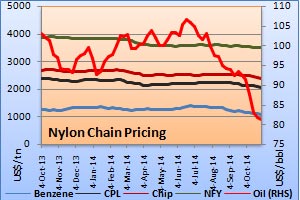
Nylon yarn makers enjoying increased margins despite soft pricing
YarnsandFibers News Bureau 2014-11-10 17:06:00 – MumbaiIncreasing supplies of crude oil from North American shale formations continued to weigh heavily on prices this year, creating a glut in world markets and decreasing demand for oil from the Organization of the Petroleum Exporting Countries. OPEC forecast that its market share would be 5 percent lower by 2018 as shale supplies continued to increase faster than demand. However, OPEC Secretary-General Abdullah al-Badri believes that the 12-member cartel, which pumps a third of the world's oil, prices would recover next year.
Falling crude oil has been decelerating pricing in downstream petrochemical derivatives. However, the cost reduction is yet to reach the end point of any manmade fibre chains. In case of nylons, filament yarn prices are yet to fully reflect the decline in upstream costs. Crude oil prices (US Futures benchmark) as declined by more than US$22 per barrel since its 2014 peak touched in June where it had averaged US$105 per barrel. In October it was down to US$82.4 per barrel. This had immediate impact on benzene prices.
In US, spot benzene prices have been moving lower amid weak crude oil, slow demand and excess supply over the past four months. From US cents 530 per gallon on 27 June, US spot benzene has lost US cents 162 by end-October. Crude oil was not only the factor. Persistently weak demand for benzene coupled with incoming cargoes from Asia, were also pushing benzene prices lower in US. Contract prices were also talked lower and settlements were still below those talks, touching the lowest since January 2012. European benzene prices were no exception has they too came down dramatically, hitting a new 4-year low as contract slumped and downstream demand almost absent.
Asian benzene markets were under the influence of movement in US benzene markets. The FOB Korea marker averaged US$1,121-1,122 a ton, down 7.2% on the month. It has lost close to US$350 a ton over the past four months.
Downstream, caprolactum prices skidded on downward benzene market and insipid downstream demand. But the fall was much lesser than that in benzene values. Asian caprolactum spot prices averaged US$2,094--2,125 a ton in October, down US$105 from June average. Nylon chip prices also continued to edge down in October, as caprolactum prices kept dropping, although in a narrow range. In China, chip suppliers reported moderate sales while semi-dull high-speed spinning nylon-6 chips, prices continued to inch down amid lukewarm buying interest. Taiwan and Korea origin chip prices showed signs of weakening due to easing of raw material costs. Offers for Taiwan-origin chips averaged US$2,436-2,470 a ton, down 2.7% over previous month and losing about US$95 from June. Thus, the price fall was even slower than the decline in caprolactum values.
Nylon filament yarn prices were stable in October despite weakening caprolactum and nylon chip prices leading to better margins for yarn makers. Although pressure on nylon yarn makers caused yarn prices to soften, and filament prices dropped just above US$50 a ton. In China, semi-dull FDY70D/24F was traded at US$3,520 a ton. This implies that demand was still supporting prices despite yarn makers partially passed on cost reduction to end users. The price spread between FDY 70D/24F SD nylon filament and semi-dull high speed spinning nylon chips of Taiwan origin was healthy at above US$1,100 a ton and between caprolactum at about US$1,450 a ton.

Courtesy: YnFx Weekly PriceWatch Report and Daily Textile Prices service
Market Intelligence
Ask for free sample Report

experience
Customer Base
dedicated team
Countries Served Worldwide









